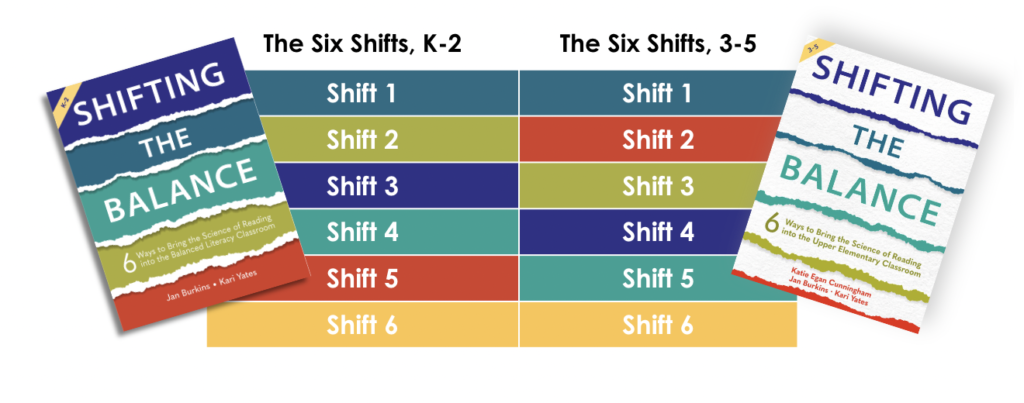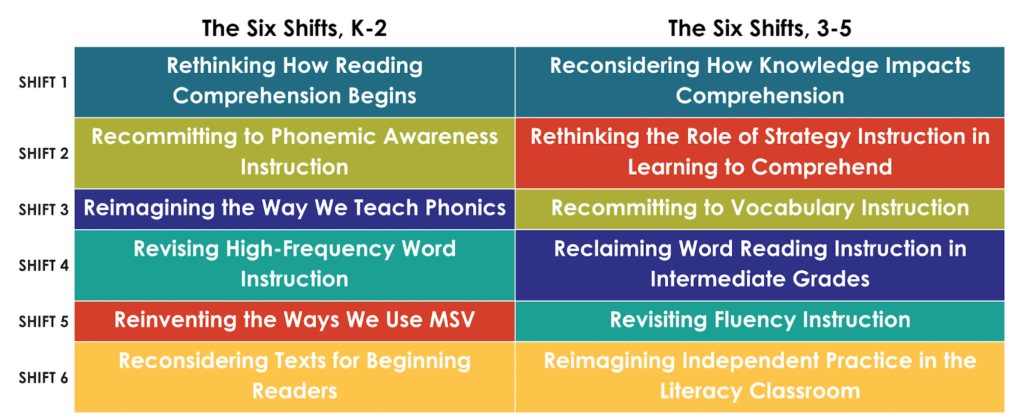Over the past two years, we’ve been touched and humbled by your overwhelming response to our first Shifting the Balance book, which we wrote to support those of you who work with beginning readers. After it was published, we quickly realized that educators were also in need of a “Part 2,” written for teachers of developing readers–those students who already had their feet under them with alphabetics and were focusing more on fluency, morphology, and comprehension. We wanted to help answer the question, “What does reading science say about readers (in any grade) who are moving beyond sound-by-sound decoding and into reading more complex texts?
Well, that Part 2 book–Shifting the Balance: 6 Ways to Bring the Science of Reading into the Upper Elementary Classroom– is now in readers’ hands! From the time we shared our first blog post about writing this sequel with co-author Katie Egan Cunningham, we’ve been getting questions from teachers about how the content in the two books connects.
First of all, we encourage you to interpret the grade-level designations on the covers of the books loosely. These grade parameters define the examples in the book, not the science. In both books, the science spills across grade levels because it isn’t actually specific to K-2 or 3-5. Rather, both books draw from a body of research that describes what brain-friendly instruction looks like for beginning readers and for developing readers.
So, if you have been wondering, “Which book is right for me?” our short answer is . . . both!
“Which book is right for me?”
Both books are written for teachers of any elementary grade. As you well know, reading development just doesn’t fit neatly into grade-level definitions! So, while the examples in each of the two books come from the grade levels indicated on the cover, the science within them applies to anyone learning to navigate either the beginning reader skillset (K-2 book) or the developing reader skillset (3-5 book).
The FIRST Six Shifts (described in the “K-2” book) show you how to lay a foundation for readers. This book is appropriate for K-2 teachers AND teachers 3-5 teachers with students who’ve had difficulty getting a strong start with reading.
The NEXT Six Shifts, described in the “3-5” book, build on the first book and are appropriate for any teacher of typically developing 3-5 students AND any K-2 readers who are developing fluency and are ready for more complex text.
If you are like most elementary teachers, you have students in both of these categories, regardless of the grade you teach. And generalizing across grades/books like this may make you wonder, “Where should I start?”
The good news is, you have choices.
The even better news is there isn’t a wrong answer. 😊 So, we want to share 4 pathways through the books for you to choose from.
Pathway #1: Start at the Beginning
In some ways, it makes sense to think of the two books as Part 1 and Part 2 rather than by their grade-level designations. If you think of the books as sequential, you can start from the beginning with the first six shifts, regardless of the grade level you teach!
The way the second book builds on the first book is indicated by the color alignment. So, Shift 1 in the first book (language comprehension) is the same color as Shift 1 in the second book (building knowledge) because the ideas in them are connected. The table below shows the connections between the two books.

Pathway #2: Think About Your Students
Start by thinking about the students you teach. Are most of them on track for reading development? Do they meet “grade-level” expectations? If most of your students are typically developing, then you should probably start with the book that has your grade-level designation on it.
On the other hand, you may be in the opposite situation. Are the majority of your students having some difficulty with reading? Are they “behind” in their reading development? Do they have gaps in their knowledge of how reading works? If the majority of your students are not performing “on grade level,” then you should start with the K-2 book, even if you teach grades 3-5.
Either way, once you read one of the books to learn how to better support the majority of your students, you can move to the sequel (or prequel) to learn about instructional shifts that will benefit your other students.
Pathway #3: Choose the Book with the Shifts that Interest You Most
This is a pathway that starts with the inside of the book and doesn’t really make any direct consideration of the grade-level specifications on the covers. The table below lists the shifts in each book. You can make your book choice by perusing each list and identifying the topics that seem most interesting or relevant to you.
Thinking a lot about what reading research says about strategy instruction? Then, you may want to start with the 3-5 book, even if you teach in K-2. Wondering what you really need to know about phonemic awareness instruction? Then you probably want to start with the K-2 book, even if you teach grades 3-5.

FYI, the shifts in each book are cumulative! So, even if Shift 2 grabs your attention, it will make a lot more sense if you read it after you read Shift 1. These are not books that lend themselves to dipping into single chapters or reading the shifts out of order. In both books, the superstructure is important and cohesive, so they make a lot more sense when read from the beginning, even if you are most excited about Shift 6.
Pathway #4: Just Start with Your Grade-Level
This is an easy and obvious pathway through the two books, which makes a lot of sense. By simply starting with the book that has the grade-level band on the cover that matches the grade you teach, you are sure to begin with content that is relevant for your students.
If you begin with the K-2 book, you can then proceed to the 3-5 book to learn about how to support students who are moving into more fluent reading. And, if you begin with the 3-5 book, you can then circle back to the K-2 book to shore up your understandings of the reading brain and how to support students who are having difficulty with reading.

Whatever path is right for you, our greatest hope for the readers of these two books is that you feel validated and empowered! We want you to have a path forward that inspires you to action.
If you would like some company through your journey through either of these books, we invite you to join a cohort of our online classes. There is a class for each book, so whichever book you choose as your starting place, we can support your journey through it using our online platform. Each class explains and extends the content of one of the books and includes extra resources, lots of short video recordings of us, and real-time Q&A sessions where we will answer the specific questions that are top-of-mind for you.
We would love to have you be a part of this online community.




Hello, I am helping organize a book study of the 3-5 book at my school. Is there a book study guide the accompany that book? Thanks!
You will find the book study resources on the Book Studies tab of the website. We wish you the best with your book study. Thanks for sharing your time and talents to support other educators with this work.